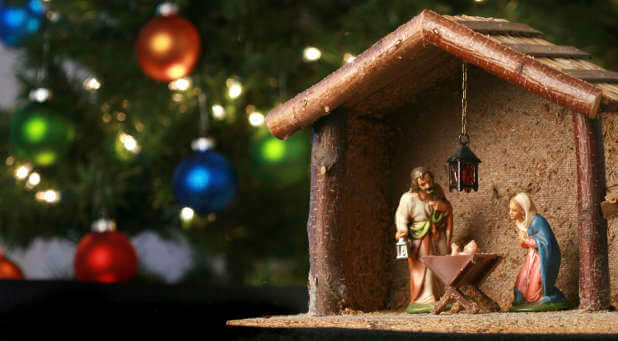I’ve often wondered what extraterrestrial aliens would think if they came to earth during December and watched people celebrate Christmas. Would they be able to figure out what this holiday season is about? I doubt it.
Today the story of Jesus’ birth is pretty much buried under tons of stringed lights, crass materialism, political correctness and songs about cold weather (which is odd, considering the fact that most people in the world celebrate Christmas in warm climates). Somehow we forgot the point of this celebration.
I proved this last week when I went to a large store to find a nativity scene. This well-known discount retailer had rows and rows of Christmas trees, Disney ornaments (because anything with a Frozen theme sells), Hello Kitty ornaments, martini ornaments (Christmas is about drinking?), inflatable penguins, Santa Claus toilet seats, Darth Vader nutcrackers, reindeer oven mitts and battery-operated Christmas hats.
But no nativity scene. When I asked a manager why they didn’t have any, he said apologetically: “You’re right. We should probably stock those.”
But I’m not going to depend on Target, Wal-Mart or Macy’s to show me the real meaning of this season. I always read the gospel accounts of Jesus’ birth in Matthew and Luke during the month of December so I can rediscover the miracle of the Incarnation.
I encourage you to study those passages as well. And as you do, meditate on these seven different names of Jesus that are recorded in the Christmas story:
1. He is the Son of David (Matt. 1:1). Matthew’s gospel, which was written primarily to Jews, stresses that Jesus was in the royal lineage of Israel’s kings. The genealogy that appears in Matthew 1 traces Joseph, the husband of the virgin Mary, to David’s line—and then back to Abraham. Even though Jesus was not the biological son of Joseph, He could legally claim the family name. He was King of the Jews in the truest sense; yet unlike the sinful kings of Israel, Jesus was the perfect ruler—and His kingdom will never end.
2. He is the Son of Adam (Luke 3:38). Luke’s gospel, written to a Gentile audience, focuses on Jesus’ humanity. And the genealogy that appears in Luke 3:23-38 is not about kingly succession. Instead, it traces Jesus’ lineage through Mary’s family tree and goes all the way to Adam—establishing the case that Jesus was a descendant of the first man. Through the supernatural work of the Holy Spirit, God’s eternal Word impregnated Mary, making her child both God and man. Yet Jesus, unlike Adam, never disobeyed God. He remained sinless so He could sacrifice His life for us.
3. He is Emmanuel (Matt. 1:23). An angel told Joseph in a dream that Mary would conceive a son miraculously—and that His name would be Emmanuel, which means, “God with us.” Wrapped up in this name is the mystery of the Incarnation. Jesus is, as John’s gospel emphasizes, the Word that “became flesh” (John 1:14). He was with God before the creation of the world as the glorious firstborn Son, but He left the glory of heaven to dwell among sinners on earth.
4. He is Jesus, the Savior (Matt. 1:21). The angel told Mary she would give birth to the “holy child” and that she would call him Jesus, which is the Greek form of the name Joshua (or Yeshua in Hebrew). Jesus means “the Lord saves.” Just as Joshua in the Old Testament succeeded Moses and took God’s people across the Jordan into the Promised Land, Jesus led us out of the wilderness of sin and ushered us “by grace” and “through faith” (Eph. 2:8) into the blessings of salvation.
5. He is the Prince of Peace (Isa. 9:6). Angels said to the shepherds in Bethlehem: “Glory to God in the highest, and on earth peace among men with whom He is pleased” (Luke 2:14). This harkens back to Isaiah’s ancient prophecy that the Messiah would institute peace on earth. The gift of Christ was, in fact, the greatest peace treaty ever enacted. Wherever the true gospel of Christ is preached and believed, hatred is uprooted in human hearts and wars and violence cease.
6. He is the Light of the Gentiles (Luke 2:32). Simeon, the old prophet who met Joseph, Mary and the baby Jesus outside the temple in Jerusalem, recognized that the long-awaited Son of God was not sent just to Israel but to all people. Jesus’ mission was a global one. This was also confirmed by the visit of the mysterious magi—wise men from a Gentile country who bowed before the Christ child and honored him as a true king. They knew that some day this King would be worshipped everywhere.
7. He is the Messiah, Christ the Lord (Luke 2:11). This is how the angel described Jesus when he spoke to the shepherds in Bethlehem. The word “Christ” means “the anointed one”; the Hebrew word is Ha-Mashiach, or Messiah. It speaks of the Deliverer God promised to send to earth. Abraham saw Him from a distance; King David sang and prophesied of Him; Isaiah, Jeremiah, Ezekiel, Daniel, Micah, Haggai, Malachi and many other prophets foretold His coming. He was not only anointed by the Holy Spirit to heal the sick and raise the dead during His short time on earth; He was anointed to die on the cross for our sins and to be raised from the dead so that we could live with Him forever.
Amid this crazy holiday madness we endure every year, let’s simplify. Filter out all the noise about snow, elves, gift cards, holiday sales and buying sprees and instead rediscover the point. Find the manger scene again—and put Jesus in the middle of your Christmas.
J. Lee Grady is the former editor of Charisma. You can follow him on Twitter at leegrady (He finally found a manger scene at Michael’s craft store).












